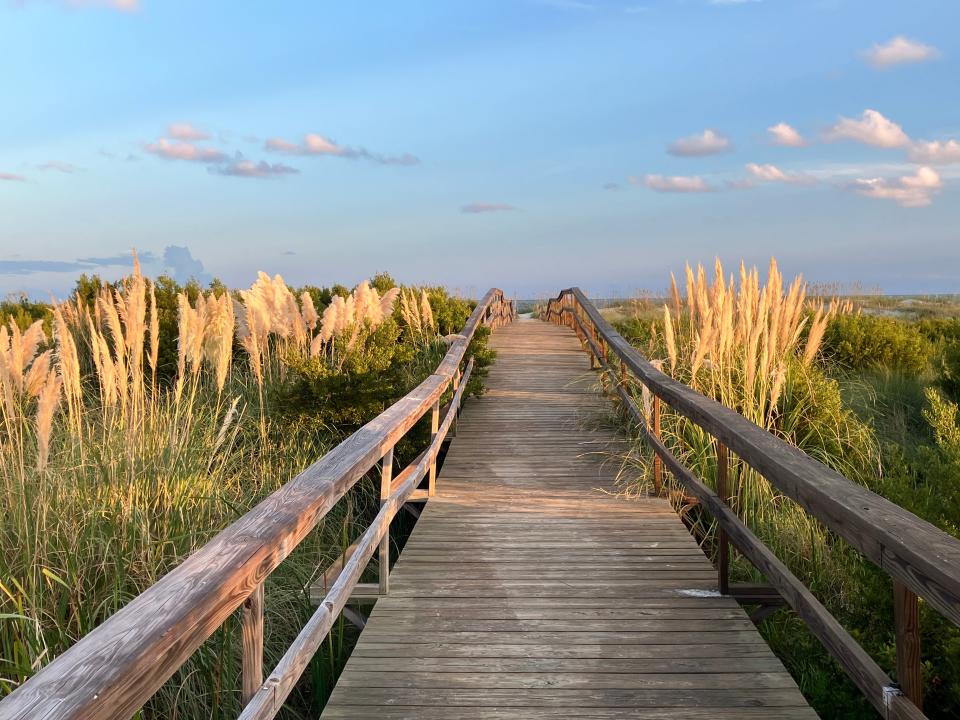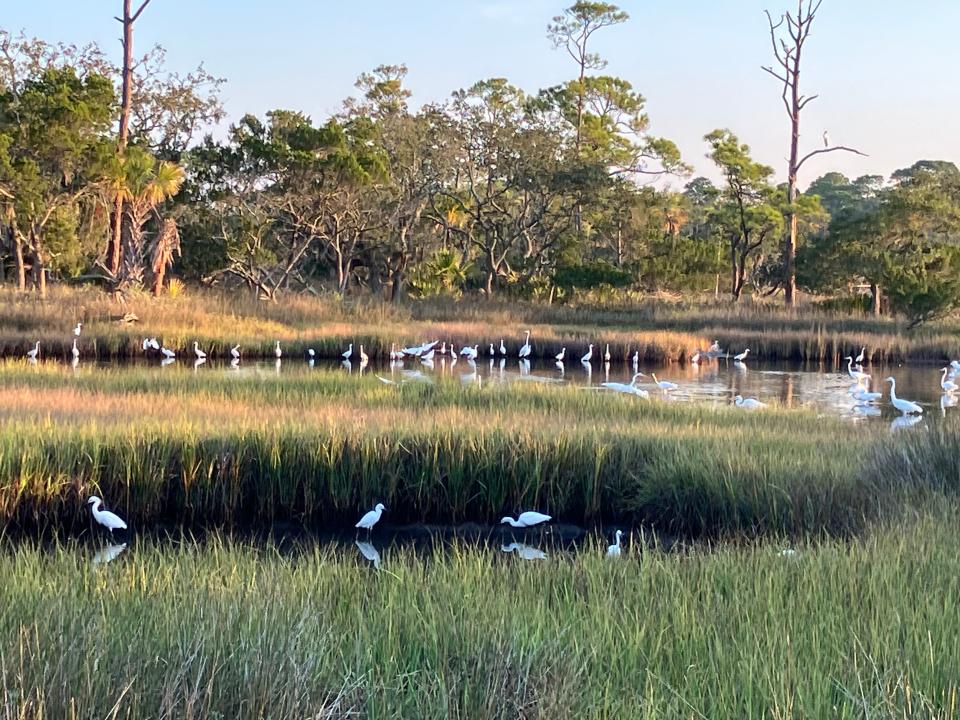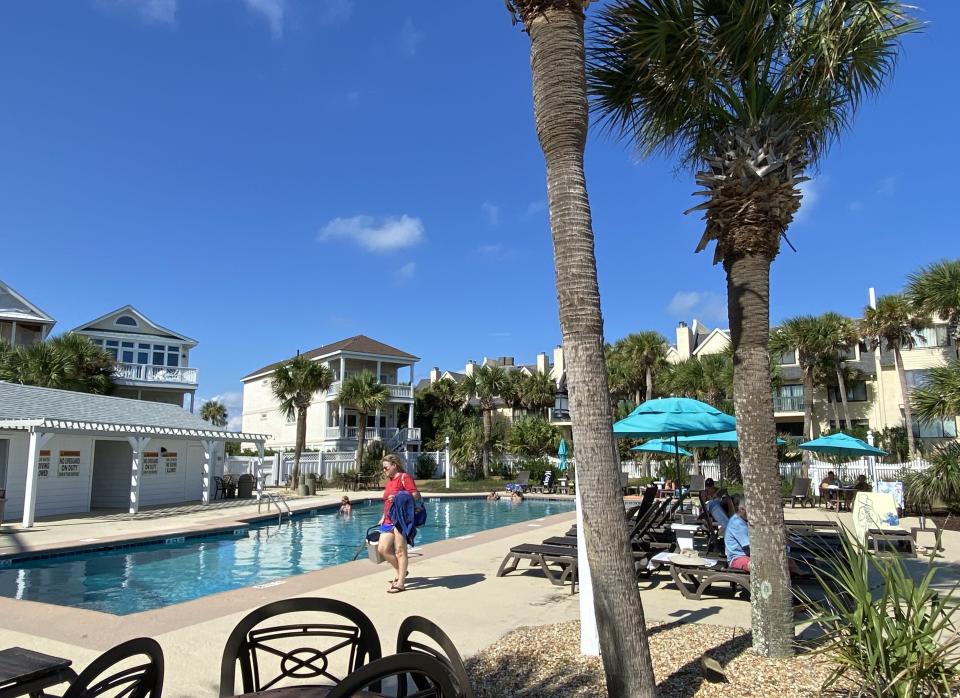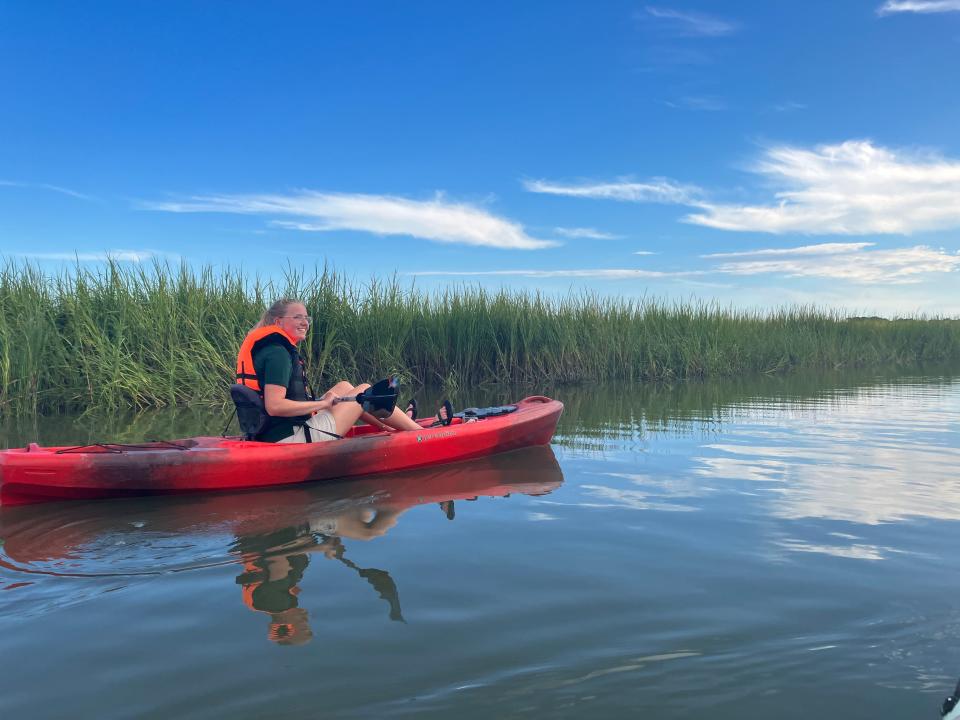Find a slice of heaven in South Carolina Low Country
- Oops!Something went wrong.Please try again later.
FRIPP ISLAND, S.C. — “I’m worried that heaven’s not going to be this pretty.”
The words were written by novelist Pat Conroy who attributed them to a friend with whom he was observing a full moon spreading ethereal light atop Atlantic Ocean waves off Fripp Island.
The most seaward of the South Carolina Sea Islands, Fripp Island holds many such moments of heavenly beauty despite measuring only 3.5 miles long and 3 miles wide.
A wade fisherman heaves his line under an early morning sun that electrifies the horizon. Dozens of egrets flittering about the tidal marsh enliven an afternoon stroll on the marsh boardwalk. The setting sun turns the sawgrass of Old House Creek a golden hue in the evening.
People have landed on Fripp Island as far back at the late 1600s when Capt. Johannes Fripp came here. He gave up pirating to defend the Carolina coast from marauders, so the tale goes. A bridge built in the early 1960s connected Fripp Island to neighboring Hunting Island and the oak-shaded roadways leading to Beaufort.
Fripp, a private island, developed into a golf and beach resort with many year-round residents and a steady flow of vacationers. The community has 2,111 housing units; 200 are available through the Fripp Island Resort Rental Program, and some others can be rented independently.
Vacationers and residents enjoy the resort’s beautiful setting and recreational activities. They like its proximity to the cultural and historic attractions in Beaufort and nearby islands.
Leisure on island time
Golf carts set the pace here. Cars are allowed on the island, but most people prefer tooling around in golf carts because they are here to chill out. The beach slopes gently into the Atlantic, making it an ideal sandscape for long barefoot walks.
The resort has five swimming pools, including three at the Cabana Club. Eating-out options range from the food trucks at the Beach Club to fine dining in Bonito Boathouse at the marina.
To many, Fripp Island is a golf resort with two stellar courses. The Ocean Creek Course, designed by PGA champion Davis Love III and Paul Cowley, is 6,392 total yards with plenty of water, especially on holes 6 and 7 along Old House Creek and its surrounding marshes. Number 9 on the Ocean Point Links borders the Atlantic Ocean. The Point was designed by George Cobb and runs 6,524 yards. Eight tennis courts and six pickleball courts stay busy at the racquet complex.
A family-friendly destination, Fripp Island features several playgrounds, bike paths and an activities center. A tradition for many families is to create the island’s signature leisurewear: the Fripp tie dye shirt. Snakes, lizards and an alligator delight the youngsters visiting the nature center. The resort’s Camelot Farms on neighboring St. Helena Island caters to equestrians.
Paddle a kayak; wet a hook
People cannot overlook the wildlife, especially when a family of deer grazes on the lawns beyond their patio. The deer are everywhere and add to the Fripp Island experience.
Paddling a kayak through Old House Creek is one way to commune with pods of dolphins. The creek weaves through a large marsh on the island’s protected side. Salt water, where dolphins live, and fresh water mix here with the rising and falling of the tide.
“Alligators, who live in fresh water, do go into the salt water, but not for too long,” naturalist Colleen Goff says as she paddles into channels that cut through a large expanse of flaxen sawgrass. Goff leads a two-hour trip through the marsh, pointing out the many shorebirds along the way.
More than 80 bird species have been spotted on the island, including bald eagle, osprey, white ibis, great blue heron and double-breasted cormorants. The National Audubon Society recognizes the importance of Fripp Island. The local chapter maintains a birding trail through the coastal forest, a marsh and a beach at Fripp Inlet.
From the marina, fishermen enjoy deep-sea charters and rent smaller boats to navigate the intercoastal waterways and rivers. They can wade fish off the beach, especially at the southern end of Skull Inlet. Fish they chase include flounder, sea trout, cobia, sea bass, Spanish mackerel and sharks.
Touring the Low Country
Many other attractions of the South Carolina Low Country are an easy reach from Fripp Island. Crossing the bridge leads to Hunting Island State Park. Here, people hike on trails, stroll on the beaches and view the lighthouse overlooking St. Helena Sound. The brick-lined iron tower was built in 1875. Beachcombers find shells, such as cockle, shark’s eye and lettered olive, strewn across five miles of pristine beach. Red Knots feed on the eggs of horseshow crabs.
Neighboring St. Helena Island is steeped in history. Remnants of the rice and indigo plantation era sit along quiet roads. The ruins of St. Helena Chapel of Ease, circa 1740, remain. It served the planters who could not ride great distances to the parish church in Beaufort; and, as the population grew, it was named a parish church.
St. Helena has a rich tradition of Gullah culture and post-Civil War activism. The Penn School served as an educational institution for formerly enslaved Africans dating back to 1862. Much later, in the 1960s, Martin Luther King Jr. was among numerous civil rights leaders who made the renamed Penn Center their base of operation. Visitors can view the Gantt Cottage where Dr. King wrote his famed “I Have a Dream” speech.
Fort Fremont, with its formidable concrete cannon emplacements, dates back to the 1890s. It was built to protect the coast during the Spanish-American War. These batteries defended Port Royal Naval Station on nearby Parris Island. The fort stands next to Lands End Beach, a secluded sand stretch favored by locals.
Beautiful Beaufort
Writer Pat Conroy, who lived on Fripp Island and in Beaufort, captured the essence of the South Carolina Low Country in novels like “The Prince of Tides” and “The Great Santini.” After his death in 2016, the Pat Conroy Literary Center was established in Beaufort to promote literary studies and support writers. Visitors to St. Helena Memorial Gardens Cemetery leave pens, shells, crosses and other artifacts at Conroy’s gravesite.
Several popular movies were filmed in and around this coastal town. Beaufort citizens are planning a 30th celebration next year of the release of “Forrest Gump.” The iconic Richard V. Woods Memorial Bridge was among the film’s settings. A horse-drawn carriage ride rolls through tree-canopied streets passing movie settings like those for “The Prince of Tides” and “The Big Chill” as well as bed-and-breakfast inns and other structures dating to the early 1700s. From the Point, a historic neighborhood with stately mansions, visitors can look across the sail-dotted bay.
In downtown Beaufort, lively places to gather are the palm-tree-shaded Waterfront Park and Bay Street. Restaurants, fashion boutiques, home décor shops, bookstores and art galleries reflect the cultural diversity of the region. This city of about 13,000 is consistently recognized as one of the country’s top small art towns.
Not to be overlooked, nearby Port Royal has quiet, small-town charm. Visitors search The Sands beach for sharks’ teeth, some hoping to find teeth of the prehistoric megalodon. Dolphins in Battery Creek swim by a boardwalk and observation tower. The Spanish Moss Trail, a 10-mile, rail-to-trail greenway, runs through Port Royal neighborhoods and wetlands.
The Parris Island Museum displays thousands of artifacts related to the development of Parris Island as a training depot for U.S. Marines, plus comprehensive exhibits of the Marines’ history and traditions.
Linda Lange and Steve Ahillen are travel writers living in Knoxville, Tenn.




This article originally appeared on Knoxville News Sentinel: Travel: Find a slice of heaven in South Carolina Low Country

